Paulus Silentiarius, Descr. S. Sophiae
This poem was recited early in 563 soon after the second consecration of the church on December 24, 562:
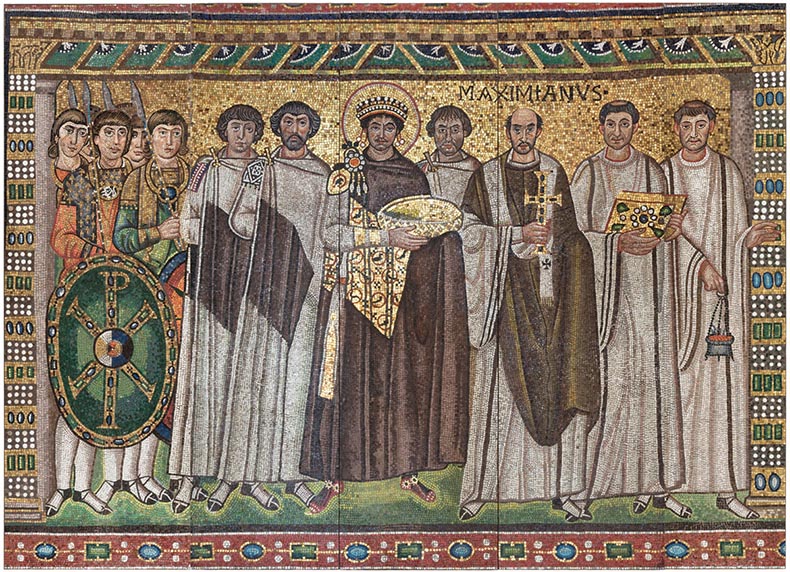
Now the wondrous curve of the half-sphere, although resting on powerful foundations, collapsed and threw down the entire precinct of the sacred house. ... Yet, the broad-breasted fane did not sink to the foundations, but the curve of the eastern arch slipped off and a portion of the dome was mingled with the dust: part of it lay on the floor, and part - a wonder to behold - hung in mid-air as if unsupported...
To the east there open the triple spaces of circles cut in half, and above, upon the upright collar of the walls, springs up the fourth part of a sphere: even so, above his triple-crested head and back does a peacock raise his many-eyed feathers. Men of the craft in their technical language call these crowning parts conches. The middle one is girded by the priestly seats and steps ranged in a circle: the lowest part of them is drawn close together round a center on the ground, but as they rise, they widen out little by little until they reach the stalls of silver, and so in ever-increasing circles they wheel round the curved wall that stands above them. This conch is followed by an arch resting on strong foundations, rectangular in plan and curved at the top, not in the form of a sphere, but in that of a cylinder cleft in twain. Two other columned conches, one on each side, extend westward like bent arms stretched out to embrace within these mansions the band of singers. These conches are lightened by columns speckled with purple bloom, ranged in half circle, holding aloft on golden capitals an overwhelming burden-columns which were once produced by the sheer crags of Thebes on the Nile. Thus on either side are the bases of each arcade upheld on twin columns, and along the traces of the threefold conch skilled workmen did bend from below smaller arches cut in half, under whose springing the columns have set their capitals, bound with bronze, carved, overlaid with gold, driving away all fear. Upon the porphyry columns stand others from Thessaly, splendid flowers of verdant stone. Here are the fair galleries for the women, and they have the same form that may be seen below, except that they are adorned not with two columns, but with six Thessalian ones. One may wonder at the resolve of the man who upon two columns has bravely set thrice two, and has not hesitated to fix their bases over empty air. All the spaces between the Thessalian columns he has fenced with stone closures upon which the women may lean and rest their laborious elbows.
Thus, as you direct your gaze towards the eastern arches, you behold a never-ceasing wonder. And upon all of them, above this covering of many curves, there rises, as it were, another arch borne on air, spreading out its swelling fold, and it rises to the top, to that high rim upon whose back is planted the base of the divine head-piece of the center of the church. Thus the deep-bosomed conch springs up into the air: at the summit it rises single, while underneath it rests on triple folds; and through five-fold openings pierced in its back it provides sources of light, sheathed in thin glass, through which, brilliantly gleaming, enters rosy-ankled Dawn.
And towards the west one may see the same forms as towards the dawn, though there is a small difference. For there in the central space it is not drawn in a curved arc as it is at the eastern end, where the priests, learned in the art of sacrifice, preside on seats resplendent with an untold wealth of silver; at the west is a great, richly-wrought portal, not a single one, but divided into three at the boundary of the temple. By the doors there stretches out a lengthy porch receiving those that enter beneath wide gates. It is as long as the wondrous church is broad; this space is called narthex by the Greeks. Here through the night there rises a melodious sound pleasing to the ears of Christ, giver of life, when the psalms of God-fearing David are sung with alternate voice by the sacred ministers. ... Into the porch there open wide seven holy gates inviting the people to enter; one of these is on the narrow face of the narthex facing south, and another on the northern wing; the rest on their groaning pivots are opened by the warden in the west wall which marks the end of the church. Whither am I driven? What wind, as upon the sea, has carried away my roaming speech? The center of the church, the most renowned place, has been neglected. Return, my song, to behold a wonder scarcely to be believed when seen or heard.
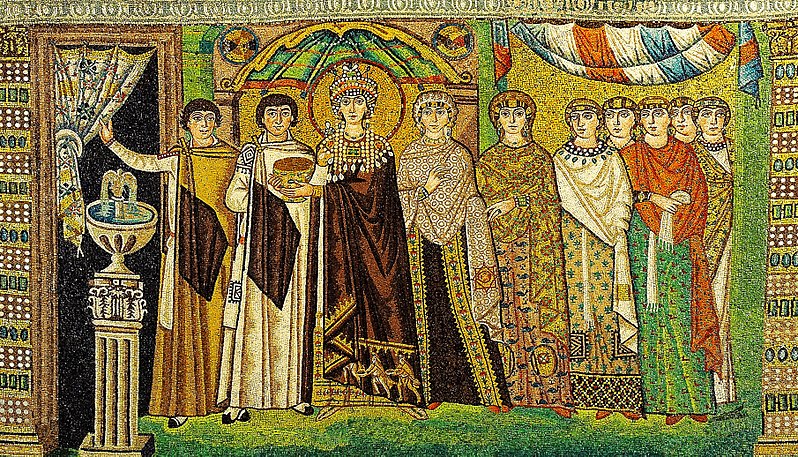 Next to the eastern and western circles - those circles cut in half - next to the twin Theban columns, are four sturdy piers, bare in front, but on their sides and powerful backs they are bound by supports from opposite directions. The four of them rest on strong foundations, fixed on solid stones. In their midst the workman has mixed and poured the dust of fire-burnt stone, thus binding them together by the builder's art. Above them are bent arches of measureless size like the many-colored rounded bow of Iris: one turns towards the wing of Zephyr, another to Boreas, another to Notus, another rises upright towards fiery Eurus. Each arch joins its unshaken foot to that of the neighboring curve at either end, and so they are fixed together on the edge, but as each rises in the air in bending line, it slowly separates from its former fellow. Now, the space between the arches is filled with a fair construction. For where they bend away from one another according to the laws of art, and would have shown empty air, there springs up a wall in the shape of a triangle, sufficiently curved so as to join the arms on either side by the common yoke of a circular rim. On four sides these walls creep over and spread out, until they are united and run up on the back of the circle like a crown. The middle portion of the arches, as much as forms the curved rim, the builder's art has compacted of baked bricks, while the ends of the bows are made of construction stone. In the joints they have put sheets of soft lead lest the stones, pressing as they do upon one another and adding rude weight to weight, should have their backs broken; but with the lead inserted, the stone foundation is gently compressed. A stone rim, rounded on all sides, has been fastened upon the backs [of the arches], where the base of the hemisphere comes down; there, too, are the winding curves of the last circle which the workmen have set like a crown upon the backs of the arches. Under this projecting adornment suspended stones have fashioned a narrow path like a fringe upon which the lamplighter may fearlessly walk round and kindle the sacred lights.
Next to the eastern and western circles - those circles cut in half - next to the twin Theban columns, are four sturdy piers, bare in front, but on their sides and powerful backs they are bound by supports from opposite directions. The four of them rest on strong foundations, fixed on solid stones. In their midst the workman has mixed and poured the dust of fire-burnt stone, thus binding them together by the builder's art. Above them are bent arches of measureless size like the many-colored rounded bow of Iris: one turns towards the wing of Zephyr, another to Boreas, another to Notus, another rises upright towards fiery Eurus. Each arch joins its unshaken foot to that of the neighboring curve at either end, and so they are fixed together on the edge, but as each rises in the air in bending line, it slowly separates from its former fellow. Now, the space between the arches is filled with a fair construction. For where they bend away from one another according to the laws of art, and would have shown empty air, there springs up a wall in the shape of a triangle, sufficiently curved so as to join the arms on either side by the common yoke of a circular rim. On four sides these walls creep over and spread out, until they are united and run up on the back of the circle like a crown. The middle portion of the arches, as much as forms the curved rim, the builder's art has compacted of baked bricks, while the ends of the bows are made of construction stone. In the joints they have put sheets of soft lead lest the stones, pressing as they do upon one another and adding rude weight to weight, should have their backs broken; but with the lead inserted, the stone foundation is gently compressed. A stone rim, rounded on all sides, has been fastened upon the backs [of the arches], where the base of the hemisphere comes down; there, too, are the winding curves of the last circle which the workmen have set like a crown upon the backs of the arches. Under this projecting adornment suspended stones have fashioned a narrow path like a fringe upon which the lamplighter may fearlessly walk round and kindle the sacred lights.
Rising above this into the immeasurable air is a helmet rounded on all sides like a sphere and, radiant as the heavens, it bestrides the roof of the church. At its very summit art has depicted a cross, protector of the city. It is a wonder to see how [the dome], wide below, gradually grows less at the top as it rises. It does not, however, form a sharp pinnacle, but is like the firmament which rests on air. ... At the very navel the sign of the cross is depicted within a circle by means of minute mosaic so that the Saviour of the whole world may for ever protect the church; while at the base of the half-sphere are fashioned forty arched windows through which the rays of fair-haired Dawn are channeled.
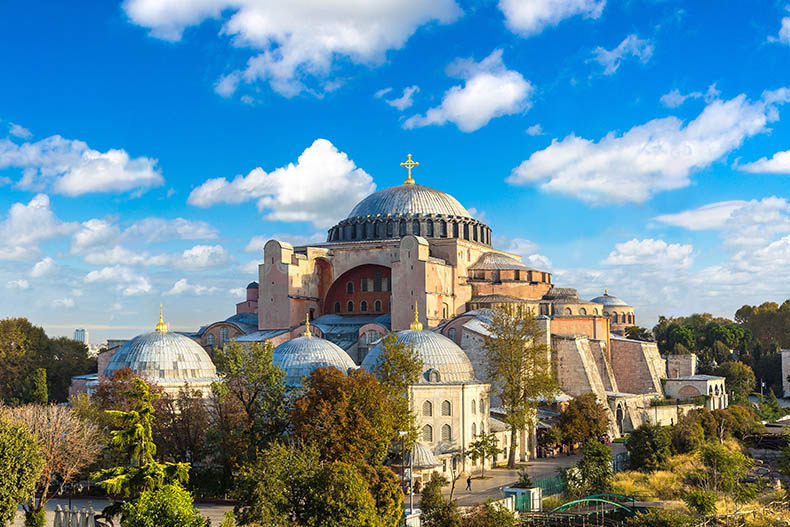 Now, towards the east and the west, you will see nothing beneath the arches: all is air. But towards the murmuring south wind and the rainless north there rises a mighty wall up to the chin of the rounded arch, and it is illuminated by twice four windows. This wall rests below on stone props, for, underneath it, six Haemonian columns, like the fresh green of the emerald, hold up a tireless sinewy juncture (it is there that the women have their seats). These in turn are heaved upon massive heads by four columns fixed immovable on the ground, glittering jewels of Thessalian marble graced with locks of golden hair.16 They separate the middle mansion of the glorious church from the lengthy aisle that lies alongside. Never were such columns, high-crested, blooming like a grove with bright flowers, cut from the land of Molossis.
Now, towards the east and the west, you will see nothing beneath the arches: all is air. But towards the murmuring south wind and the rainless north there rises a mighty wall up to the chin of the rounded arch, and it is illuminated by twice four windows. This wall rests below on stone props, for, underneath it, six Haemonian columns, like the fresh green of the emerald, hold up a tireless sinewy juncture (it is there that the women have their seats). These in turn are heaved upon massive heads by four columns fixed immovable on the ground, glittering jewels of Thessalian marble graced with locks of golden hair.16 They separate the middle mansion of the glorious church from the lengthy aisle that lies alongside. Never were such columns, high-crested, blooming like a grove with bright flowers, cut from the land of Molossis.
But in the midst of the aisle, too, Anthemius of many crafts assisted by the wisdom of Isidorus (for both of them, serving the will of the industrious Emperor, have built this prodigious church) have set up four more columns, shorter in measure than their neighbors, but as bright with verdant bloom, being as they are from the same quarry. Their goodly feet are not planted in the ground all in a row: instead, they are set on the pavement in facing pairs, and upon their heads, a vault (kerai), wound on fourfold arches, supports the underside of the women's abode. Close by, in the direction of the north wind is a door that leads the people to the pure founts that cleanse human life and drive away the grievous scars of sin.
Following these four graceful Thessalian columns, on either side, namely towards dusk and dawn, pierced cylindrical vaults are poised on the divinely built walls along the length of the aisle and serve for passage. Towards the north wind they open into double doors, whereas towards the south, over against the doors, are well-wrought spaces like chambers. And again towards the day and night stand two other columns from the Haemus and two pillars with lofty crests from famous Proconnesus, set close to the doors. Towards the east there is but one door, while towards the abode of black night the people enter through a double portal.
On the south you will find a long aisle altogether similar to the northern one, yet it has something in addition: for it contains a space separated by a wall, reserved for the Ausonian emperor on solemn festivals. Here my sceptered king, seated on his customary throne, lends his car to [the reading of] the sacred books.
And whoever mounts up will find that the women's aisles on either side are similar to those below; but the one that runs above the narthex, to the west, is not like the other two.
Now on the western side of this divine church you will see a court encompassed by four aisles: one of these is joined to the narthex, while the others are open wide, and various paths lead to them. At the prized center of the wide court stands a spacious fountain, cleft from the Iasian peaks; from it a burbling stream of water, forced by a brazen pipe, leaps into the air - a stream that drives away all suffering, when the people, in the month of the golden vestments, at God's mystic feast, draw by night the unsullied waters in vessels.
Upon the carved stone wall curious designs glitter everywhere. These have been produced by the quarries of sea-girt Proconnesus. The joining of the cut marbles resembles the art of painting for you may see the veins of the square and octagonal stones meeting so as to form devices: connected in this way, the stones imitate the glories of painting. And outside the divine church you may see everywhere, along its flanks and boundaries, many open courts. These have been fashioned with cunning skill about the holy building that it may appear bathed all round by the bright light of day. Yet who, even in the thundering strains of Homer, shall sing the marble meadows gathered upon the mighty walls and spreading pavement of the lofty church? Mining [tools of] toothed steel have cut these from the green flanks of Carystus and have cleft the speckled Phrygian stone, sometimes rosy mixed with white, sometimes gleaming with purple and silver flowers. There is a wealth of porphyry stone, too, besprinkled with little bright stars that had laden the river-boat on the broad Nile. You may see the bright green stone of Laconia and the glittering marble with wavy veins found in the deep gullies of the Iasian peaks, exhibiting slanting streaks of blood-red and livid white; the pale yellow with swirling red from the Lydian headland; the glittering crocus-like golden stone which the Libyan sun, warming it with its golden light, has produced on the steep flanks of the Moorish hills; that of glittering black upon which the Celtic crags, deep in ice, have poured here and there an abundance of milk; the pale onyx with glint of precious metal; and that which the land of Atrax yields, not from some upland glen, but from the level plain: in parts vivid green not unlike emerald, in others of a darker green, almost blue. It has spots resembling snow next to flashes of black so that in one stone various beauties mingle.
Before one comes to the glitter of cut mosaic, the mason, weaving together with his hands thin slabs of marble, has figured upon the walls connected arcs laden with fruit, baskets and leaves, and has represented birds perched on boughs. The twining vine with shoots like golden ringlets winds its curving path and weaves a spiral chain of clusters. It projects gently forward so as to overshadow somewhat with its twisting wreaths the stone that is next to it. Such ornament surrounds the beauteous church. And above the high-crested columns, underneath the projecting stone edge, is deployed a tapestry of wavy acanthus, a wandering contexture of spiky points, all golden, full of grace. It encompasses marble shields-discs of porphyry glittering with a beauty that charms the heart.
The hills of Proconnesus have gladly offered their back to the life-giving Queen to cover the entire floor, while the polish of Bosporus stone shimmers gently, black with an admixture of white.
The roof is compacted of gilded tesserae from which a glittering stream of golden rays pours abundantly and strikes men's eyes with irresistible force. It is as if one were gazing at the midday sun in spring, when he gilds each mountain top.
Indeed, our emperor, who has gathered all manner of wealth from the whole earth, from barbarians and Ausonians alike, did not deem a stone adornment sufficient for this divine, immortal temple in which Rome has placed all its proud hopes of joy. He has not spared, too, an abundant enrichment of silver. The ridge of Pangaeus and the cape of Sunium have opened all their silver veins, and many a treasure-house of our lords has yielded its stores.
For as much of the great church by the eastern arch as was set apart for the bloodless sacrifice is bounded not with ivory or cut stone or bronze, but it is all fenced under a cover of silver. Not only upon the walls which separate the priest from the choir of singers has he set plates of naked silver, but the columns, too, six sets of twain in number, he has completely covered with the silver metal, and they send forth their rays far and wide. Upon them the tool wielded by a skilled hand has artfully hollowed out discs more pointed than a circle, within which it has engraved the figure of the immaculate God who, without seed, clothed himself in human form. Elsewhere it has carved the host of winged angels bowing down their necks, for they are unable to gaze upon the glory of God, though hidden under a veil of human form - He is still God, even if He has put on the flesh that removes sin. Elsewhere the sharp steel has fashioned those former heralds of God by whose words, before God had taken on flesh, the divine tidings of Christ's coming spread abroad. Nor has the artist forgotten the images of those who abandoned the mean labors of their life - the fishing basket and the net and those evil cares in order to follow the command of the heavenly King, fishing even for men and, instead of casting for fish, spread out the nets of eternal life. And elsewhere art has depicted the Mother of Christ, the vessel of eternal life, whose holy womb did nourish its own Maker. And on the middle panels of the sacred screen which form a barrier round the sanctified priests, the carver's tool has incised one symbol that means many words, for it combines the names of the Empress and Emperor: It is like a shield with a boss in whose middle part has been carved the sign of the cross. And the screen gives access to the priests through three doors. For on each side the workman's hand has made a small door.
And above the all-pure table of gold rises into the ample air an indescribable tower, reared on fourfold arches of silver. It is borne aloft on silver columns on whose tops each of the four arches has planted its silver feet. And above the arches springs up a figure like a cone, yet it is not exactly a cone: for at the bottom its rim does not turn round in a circle, but has an eight-sided base, and from a broad plan it gradually creeps up to a sharp point, stretching out as it does so eight sides of silver. At the juncture of each to the other stand long backbones which seem to join their course with the triangular faces of the eight-sided form and rise to a single crest where the artist has placed the form of a cup. The lip of the cup bends over and assumes the shape of leaves, and in the midst of it has been placed a shining silver orb, and a cross surmounts it all. May it be propitious! Above the arches many a curve of acanthus twists round the lower part of the cone, while at the top, rising over the edge, it terminates in upright points resembling the fragrant fruit of the fair-leaved peartree, glittering with light. Now where the sides of the base are fitted to each other are fixed silver bowls, and in each bowl is set a candelabrum like a candle that burns not, expressing beauty rather than giving light; for these are fashioned all round of silver, brightly polished. Thus the candle flashes a silver ray, not the light of fire. And on columns of gold is raised the all-gold slab of the holy table, standing on gold foundations, and bright with the glitter of precious stones.
Whither am I carried? Whither tends my unbridled speech? Let my bold voice be restrained with silent lip lest I lay bare what the eyes are not permitted to see. But ye priests, as the sacred laws command you, spread out with your hands the veil dipped in the purple dye of the Sidonian shell and cover the top of the table. Unfold the cover along its four sides and show to the countless crowd the gold and the bright designs of skillful handiwork. One side is adorned with Christ's venerable form. This has been fashioned not by artists' skillful hands plying the knife, nor by the needle driven through cloth, but by the web, the produce of the foreign worm, changing its colored threads of many shades. Upon the divine legs is a garment reflecting a golden glow under the rays of rosy fingered Dawn, and a chiton, dyed purple by the Tyrian seashell, covers the right shoulder beneath its well-woven fabric; for at that point the upper garment has slipped down while, pulled up across the side, it envelops the left shoulder. The forearm and hand are thus laid bare. He seems to be stretching out the fingers of the right hand, as if preaching His immortal words, while in His left He holds the book of divine message—the book that tells what He, the Lord, accomplished with provident mind when His foot trod the earth. The whole robe shines with gold: for on it gold leaf has been wrapped round thread after the manner of a pipe or a reed, and so it projects above the lovely cloth, firmly bound with silken thread by sharp needles. On either side stand two of God's messengers: Paul, replete with divine wisdom, and the mighty doorkeeper of the gates of heaven who binds with both heavenly and earthly bonds. One holds the book pregnant with holy ordinance, the other the form of the cross on a golden staff. And both the cunning web has clothed in robes woven of silver; while rising above their immortal heads a golden temple enfolds them with three noble arches fixed on four columns of gold. And on the hem of the veil shot with gold, art has figured the countless deeds of the Emperors, guardians of the city: here you may see hospitals for the sick, there sacred fanes. And elsewhere are displayed the miracles of heavenly Christ, a work suffused with beauty. And upon other veils you may see the monarchs joined together, here by the hand of Mary, the Mother of God, there by that of Christ, and all is adorned with the sheen of golden thread.
Thus is everything clothed in beauty; everything fills the eye with wonder. But no words are sufficient to describe the illumination in the evening: you might say that some nocturnal sun filled the majestic temple with light. For the deep wisdom of our Emperors has stretched from the projecting stone cornice, on whose back is planted the foot of the temple's lofty dome, long twisted chains of beaten brass, linked in alternating curves by many hooks. From many points on a long course these fall together to the ground, but before they reach the floor, their lofty path is checked and they form an even choir. And to each chain he has attached silver discs, suspended circle-wise in the air round the central confines of the church. Thus, descending from their lofty course, they float in a circle above the heads of men. The cunning craftsman has pierced the discs all over with his iron tool so that they may receive shafts of fire-wrought glass and provide pendent sources of light for men at night. Yet not from discs alone does the light shine at night, for in the [same] circle you will see, next to the discs, the shape of the lofty cross with many eyes upon it, and in its pierced back it holds luminous vessels. Thus hangs the circling choir of bright lights. You might say you were gazing on the effulgent stars of the heavenly Corona close to Arcturus and the head of Draco. Thus the evening light revolves round the temple, brightly shining. And in a smaller, inner circle you will find a second crown bearing lights along its rim, while in the very center another noble disc rises shining in the air, so that darkness is made to flee.
By the aisles, too, next to the columns on either side, they have placed in sequence single lamps, one apart from the other, and they go through the whole length of the far-stretching church. Beneath each they have placed a silver vessel resembling a balance pan, and in the center of this rests a cup of burning oil. There is not, however, one equal level for all the lamps, but you will see some high, some low, in lovely curves of light as they glitter step-wise on their aerial path, suspended from twisted chains. In this manner does the twin-pointed Hyas shine, fixed in the parted forehead of Taurus. One may also see ships of silver bearing a luminous freight; suspended, they sail through the bright air instead of the sea, fearing neither the south wind nor late-setting Boutes. And down on the floor you will see elegant beams running between two-horned supports of iron, upon which extends a row of lights, servitors of the temple, connected by straight rods of red color. Some of these are on the floor, where the elegant columns have set their bases, while others are above the capitals following the long path of the walls.
Neither has the base of the deep-bosomed dome been left without light, for along the projecting stone of the curved cornice the priest has lit single lamps attached to bronze stakes. Just as a king, cherishing his virgin daughter, might place round her neck a lovely chain glowing like fire with rubies set in gold, so has our Emperor fixed round the cornice a revolving circle of lights that run along the whole base.
There is also on the silver columns, above their capitals, a narrow path of access for the lamplighters, a path full of light, glittering with bright clusters; these one might compare to the mountain-reared pine tree or to the cypress of tender foliage. Pointed at the summit, they are ringed by circles that gradually widen down to the lowest curve that surrounds the base of the trunk; and upon them have grown fiery flowers. Instead of a root, bows of silver have been affixed beneath these trees of flaming vegetation. And in the center of this beauteous grove, the form of the divine cross, studded with bright nails, blazes with light for mortal eyes.
Countless other lights, hanging on twisted chains, does the church of ever-changing aspect contain within itself; some illumine the aisles, others the center or the east and west, others shed their bright flame at the summit. Thus the bright night smiles like the day and appears herself to be rosy-ankled. ...
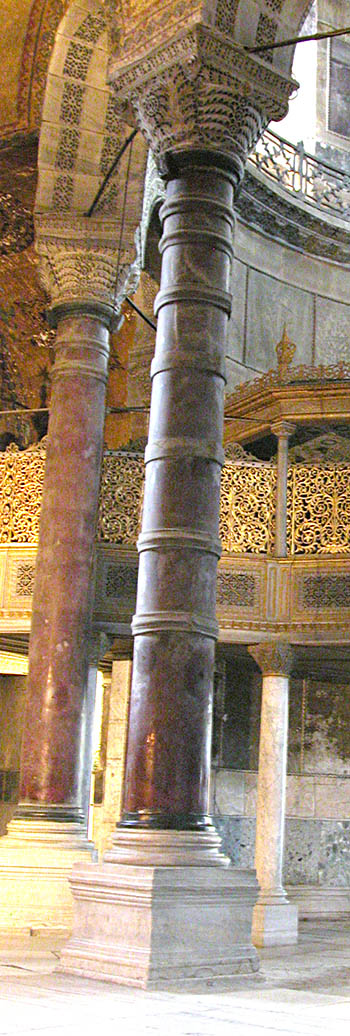
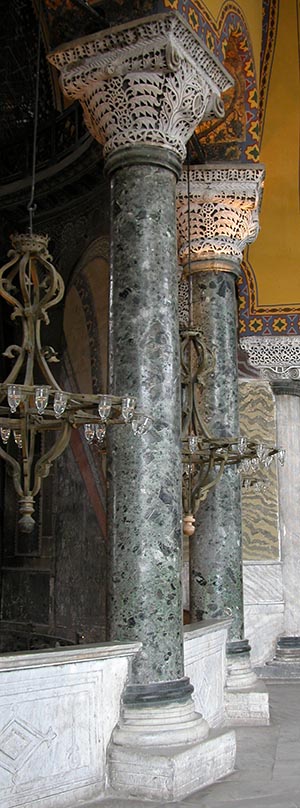
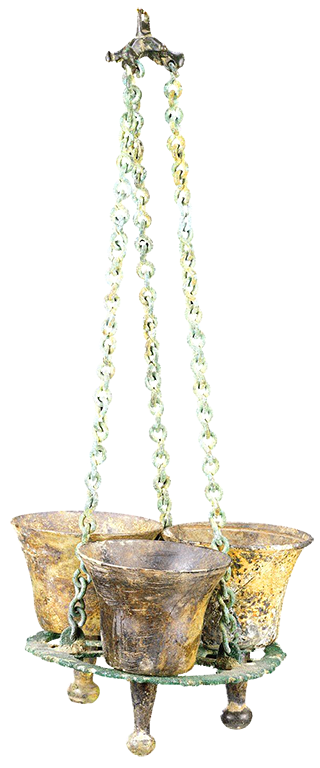



 Next to the eastern and western circles - those circles cut in half - next to the twin Theban columns, are four sturdy piers, bare in front, but on their sides and powerful backs they are bound by supports from opposite directions. The four of them rest on strong foundations, fixed on solid stones. In their midst the workman has mixed and poured the dust of fire-burnt stone, thus binding them together by the builder's art. Above them are bent arches of measureless size like the many-colored rounded bow of Iris: one turns towards the wing of Zephyr, another to Boreas, another to Notus, another rises upright towards fiery Eurus. Each arch joins its unshaken foot to that of the neighboring curve at either end, and so they are fixed together on the edge, but as each rises in the air in bending line, it slowly separates from its former fellow. Now, the space between the arches is filled with a fair construction. For where they bend away from one another according to the laws of art, and would have shown empty air, there springs up a wall in the shape of a triangle, sufficiently curved so as to join the arms on either side by the common yoke of a circular rim. On four sides these walls creep over and spread out, until they are united and run up on the back of the circle like a crown. The middle portion of the arches, as much as forms the curved rim, the builder's art has compacted of baked bricks, while the ends of the bows are made of construction stone. In the joints they have put sheets of soft lead lest the stones, pressing as they do upon one another and adding rude weight to weight, should have their backs broken; but with the lead inserted, the stone foundation is gently compressed. A stone rim, rounded on all sides, has been fastened upon the backs [of the arches], where the base of the hemisphere comes down; there, too, are the winding curves of the last circle which the workmen have set like a crown upon the backs of the arches. Under this projecting adornment suspended stones have fashioned a narrow path like a fringe upon which the lamplighter may fearlessly walk round and kindle the sacred lights.
Next to the eastern and western circles - those circles cut in half - next to the twin Theban columns, are four sturdy piers, bare in front, but on their sides and powerful backs they are bound by supports from opposite directions. The four of them rest on strong foundations, fixed on solid stones. In their midst the workman has mixed and poured the dust of fire-burnt stone, thus binding them together by the builder's art. Above them are bent arches of measureless size like the many-colored rounded bow of Iris: one turns towards the wing of Zephyr, another to Boreas, another to Notus, another rises upright towards fiery Eurus. Each arch joins its unshaken foot to that of the neighboring curve at either end, and so they are fixed together on the edge, but as each rises in the air in bending line, it slowly separates from its former fellow. Now, the space between the arches is filled with a fair construction. For where they bend away from one another according to the laws of art, and would have shown empty air, there springs up a wall in the shape of a triangle, sufficiently curved so as to join the arms on either side by the common yoke of a circular rim. On four sides these walls creep over and spread out, until they are united and run up on the back of the circle like a crown. The middle portion of the arches, as much as forms the curved rim, the builder's art has compacted of baked bricks, while the ends of the bows are made of construction stone. In the joints they have put sheets of soft lead lest the stones, pressing as they do upon one another and adding rude weight to weight, should have their backs broken; but with the lead inserted, the stone foundation is gently compressed. A stone rim, rounded on all sides, has been fastened upon the backs [of the arches], where the base of the hemisphere comes down; there, too, are the winding curves of the last circle which the workmen have set like a crown upon the backs of the arches. Under this projecting adornment suspended stones have fashioned a narrow path like a fringe upon which the lamplighter may fearlessly walk round and kindle the sacred lights. Now, towards the east and the west, you will see nothing beneath the arches: all is air. But towards the murmuring south wind and the rainless north there rises a mighty wall up to the chin of the rounded arch, and it is illuminated by twice four windows. This wall rests below on stone props, for, underneath it, six Haemonian columns, like the fresh green of the emerald, hold up a tireless sinewy juncture (it is there that the women have their seats). These in turn are heaved upon massive heads by four columns fixed immovable on the ground, glittering jewels of Thessalian marble graced with locks of golden hair.16 They separate the middle mansion of the glorious church from the lengthy aisle that lies alongside. Never were such columns, high-crested, blooming like a grove with bright flowers, cut from the land of Molossis.
Now, towards the east and the west, you will see nothing beneath the arches: all is air. But towards the murmuring south wind and the rainless north there rises a mighty wall up to the chin of the rounded arch, and it is illuminated by twice four windows. This wall rests below on stone props, for, underneath it, six Haemonian columns, like the fresh green of the emerald, hold up a tireless sinewy juncture (it is there that the women have their seats). These in turn are heaved upon massive heads by four columns fixed immovable on the ground, glittering jewels of Thessalian marble graced with locks of golden hair.16 They separate the middle mansion of the glorious church from the lengthy aisle that lies alongside. Never were such columns, high-crested, blooming like a grove with bright flowers, cut from the land of Molossis.



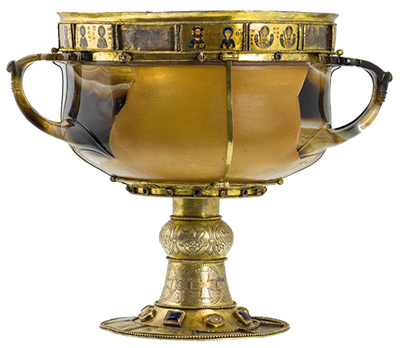
 click here for icons of christ
click here for icons of christ click here for icons of the theotokos
click here for icons of the theotokos click here for icons of angels
click here for icons of angels click here for icons of saints
click here for icons of saints








